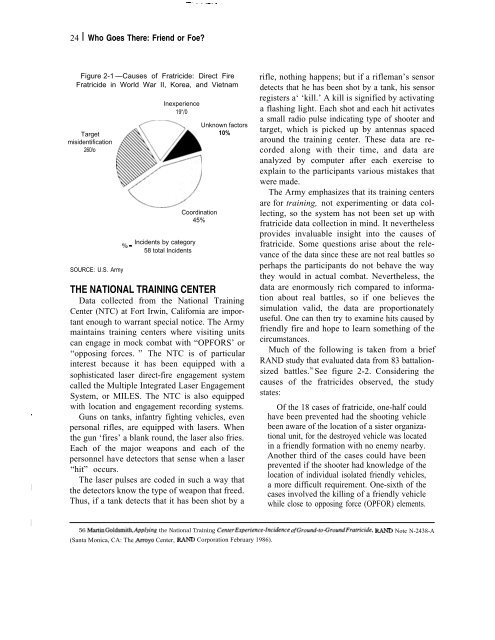Who Goes There: Friend or Foe? - Federation of American Scientists
Who Goes There: Friend or Foe? - Federation of American Scientists
Who Goes There: Friend or Foe? - Federation of American Scientists
You also want an ePaper? Increase the reach of your titles
YUMPU automatically turns print PDFs into web optimized ePapers that Google loves.
—. -.—. .<br />
24 I <strong>Who</strong> <strong>Goes</strong> <strong>There</strong>: <strong>Friend</strong> <strong>or</strong> <strong>Foe</strong>?<br />
Figure 2-1 —Causes <strong>of</strong> Fratricide: Direct Fire<br />
Fratricide in W<strong>or</strong>ld War II, K<strong>or</strong>ea, and Vietnam<br />
Target<br />
misidentification<br />
260/o<br />
SOURCE: U.S. Army<br />
Inexperience<br />
19“/0<br />
(’- Unknown fact<strong>or</strong>s<br />
10%<br />
\/<br />
Co<strong>or</strong>dination<br />
45%<br />
“,0 = Incidents by categ<strong>or</strong>y<br />
58 total Incidents<br />
THE NATIONAL TRAINING CENTER<br />
Data collected from the National Training<br />
Center (NTC) at F<strong>or</strong>t Irwin, Calif<strong>or</strong>nia are imp<strong>or</strong>tant<br />
enough to warrant special notice. The Army<br />
maintains training centers where visiting units<br />
can engage in mock combat with “OPFORS’ <strong>or</strong><br />
“opposing f<strong>or</strong>ces. ” The NTC is <strong>of</strong> particular<br />
interest because it has been equipped with a<br />
sophisticated laser direct-fire engagement system<br />
called the Multiple Integrated Laser Engagement<br />
System, <strong>or</strong> MILES. The NTC is also equipped<br />
with location and engagement rec<strong>or</strong>ding systems.<br />
\<br />
Guns on tanks, infantry fighting vehicles, even<br />
personal rifles, are equipped with lasers. When<br />
the gun ‘fires’ a blank round, the laser also fries.<br />
Each <strong>of</strong> the maj<strong>or</strong> weapons and each <strong>of</strong> the<br />
personnel have detect<strong>or</strong>s that sense when a laser<br />
“hit” occurs.<br />
The laser pulses are coded in such a way that<br />
I the detect<strong>or</strong>s know the type <strong>of</strong> weapon that freed.<br />
Thus, if a tank detects that it has been shot by a<br />
I<br />
rifle, nothing happens; but if a rifleman’s sens<strong>or</strong><br />
detects that he has been shot by a tank, his sens<strong>or</strong><br />
registers a‘ ‘kill.’ A kill is signified by activating<br />
a flashing light. Each shot and each hit activates<br />
a small radio pulse indicating type <strong>of</strong> shooter and<br />
target, which is picked up by antennas spaced<br />
around the training center. These data are rec<strong>or</strong>ded<br />
along with their time, and data are<br />
analyzed by computer after each exercise to<br />
explain to the participants various mistakes that<br />
were made.<br />
The Army emphasizes that its training centers<br />
are f<strong>or</strong> training, not experimenting <strong>or</strong> data collecting,<br />
so the system has not been set up with<br />
fratricide data collection in mind. It nevertheless<br />
provides invaluable insight into the causes <strong>of</strong><br />
fratricide. Some questions arise about the relevance<br />
<strong>of</strong> the data since these are not real battles so<br />
perhaps the participants do not behave the way<br />
they would in actual combat. Nevertheless, the<br />
data are en<strong>or</strong>mously rich compared to inf<strong>or</strong>mation<br />
about real battles, so if one believes the<br />
simulation valid, the data are prop<strong>or</strong>tionately<br />
useful. One can then try to examine hits caused by<br />
friendly fire and hope to learn something <strong>of</strong> the<br />
circumstances.<br />
Much <strong>of</strong> the following is taken from a brief<br />
RAND study that evaluated data from 83 battalionsized<br />
battles. 56<br />
See figure 2-2. Considering the<br />
causes <strong>of</strong> the fratricides observed, the study<br />
states:<br />
Of the 18 cases <strong>of</strong> fratricide, one-half could<br />
have been prevented had the shooting vehicle<br />
been aware <strong>of</strong> the location <strong>of</strong> a sister <strong>or</strong>ganizational<br />
unit, f<strong>or</strong> the destroyed vehicle was located<br />
in a friendly f<strong>or</strong>mation with no enemy nearby.<br />
Another third <strong>of</strong> the cases could have been<br />
prevented if the shooter had knowledge <strong>of</strong> the<br />
location <strong>of</strong> individual isolated friendly vehicles,<br />
a m<strong>or</strong>e difficult requirement. One-sixth <strong>of</strong> the<br />
cases involved the killing <strong>of</strong> a friendly vehicle<br />
while close to opposing f<strong>or</strong>ce (OPFOR) elements.<br />
56 M~~GoldSfi@APplying the National Training ce~terExpen”ence-Incidence <strong>of</strong>Ground-to-GroundFratricide, R4ND Note N-2438-A<br />
(Santa Monica, CA: The Arroyo Center, R4ND C<strong>or</strong>p<strong>or</strong>ation February 1986).
















